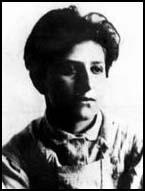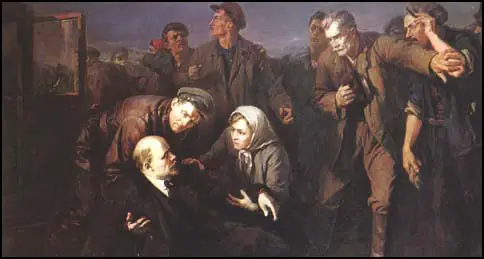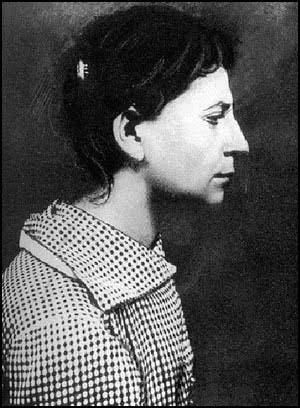Fanya Kaplan

Fanya Kaplan was born on 10th February, 1890, into a poor peasant family and her four brothers and two sisters were all educated at home. Her parents both emigrated to the United States.
Kaplan became involved in radical politics and joined the Socialist Revolutionary Party. In 1906 she took part in a plot to kill a Tsarist official in Kiev. Kaplan was caught and sentenced to a life of hard labour in Siberia. She later recalled: "I was exiled to Akatoi for participating in an assassination attempt against a Tsarist official in Kiev. I spent eleven years at hard labour." (1)
After eleven years in Siberia she was released after the February Revolution. Like many Mensheviks and Socialist Revolutionaries, Kaplan was furious when the Bolsheviks closed down the Constituent Assembly and decided that she would assassinate Lenin as a means of protesting against this measure. (2)
On 30th August, 1918, Lenin spoke at a meeting in Moscow. Victor Serge later explained what happened: "Lenin arrived alone; no one escorted him and no one formed a reception party. When he came out, workers surrounded him for a moment a few paces from his car." As he left the building Kaplan tried to ask Lenin some questions about the way he was running the country. Just before he got into his car Lenin turned to answer the woman. Serge then explained what happened next: "It was at this moment Kaplan fired at him, three times, wounding him seriously in the neck and shoulder. Lenin was driven back to the Kremlin by his chauffeur, and just had the strength to walk upstairs in silence to the second floor: then he fell in pain. There was great anxiety for him: the wound in the neck could have proved extremely serious; for a while it was thought that he was dying." (3)

Kaplan was soon captured and in a statement she made to Cheka that night, she explained that she had attempted to kill him because he had closed down the Constituent Assembly. In a statement to the police she confessed to trying to kill Lenin. "My name is Fanya Kaplan. Today I shot at Lenin. I did it on my own. I will not say whom I obtained my revolver. I will give no details. I had resolved to kill Lenin long ago. I consider him a traitor to the Revolution. I was exiled to Akatui for participating in an assassination attempt against a Tsarist official in Kiev. I spent 11 years at hard labour. After the Revolution, I was freed. I favoured the Constituent Assembly and am still for it." (4)

Fanya Kaplan was shot by Pavel Malkov, a Baltic Fleet sailor, on 3rd September, 1918. Yakov Sverdlov, who organized the execution, gave instructions that she was not to be buried. He told Malkov: "her remains are to be destroyed so that not a trace remains." Malkov later recalled: "The execution of a human being, especially a woman, was no easy thing. It was a heavy, very heavy responsibility. But I had never been ordered to carry out a more just sentence than this." (5)
The attempt on Lenin's life and the assassination of Moisei Uritsky, chief of the Petrograd Secret Police, concerned the leadership of the Bolsheviks. Joseph Stalin, who was in Tsaritsyn at the time, sent a telegram to Yakov Sverdlov suggesting: "having learned about the wicked attempt of capitalist hirelings on the life of the greatest revolutionary, the tested leader and teacher of the proletariat, Comrade Lenin, answer this base attack from ambush with the organization of open and systematic mass terror against the bourgeoisie and its agents." (6)
Leon Trotsky agreed and argued in My Life: An Attempt at an Autobiography (1930): "The Socialist-Revolutionaries had killed Volodarsky and Uritzky, had wounded Lenin seriously, and had made two attempts to blow up my train. We could not treat this lightly. Although we did not regard it from the idealistic point of view of our enemies, we appreciated the role of the individual in history. We could not close our eyes to the danger that threatened the revolution if we were to allow our enemies to shoot down, one by one, the whole leading group of our party." (7)
The Bolsheviks newspaper, Krasnaya Gazeta, reported on 1st September, 1918: "We will turn our hearts into steel, which we will temper in the fire of suffering and the blood of fighters for freedom. We will make our hearts cruel, hard, and immovable, so that no mercy will enter them, and so that they will not quiver at the sight of a sea of enemy blood. We will let loose the floodgates of that sea. Without mercy, without sparing, we will kill our enemies in scores of hundreds. Let them be thousands; let them drown themselves in their own blood. For the blood of Lenin and Uritsky, Zinovief and Volodarski, let there be floods of the blood of the bourgeois - more blood, as much as possible." (8)
The advice of Stalin, who had used these tactics successfully in Tsaritsyn, was accepted and in September, 1918, Felix Dzerzhinsky, head of the Cheka, instigated the Red Terror. It is estimated that in the few months after the attempt on the life of Lenin, over 800 socialists were arrested and shot without trial. A Foreign Office report in February, 1919, claimed: "The political parties which have been most oppressed by the Bolsheviks are the Socialists, Social Democrats and Social Revolutionaries. Owing to bribery and corruption - those notorious evils of the old regime which are now multiplied under Bolshevism - capitalists were able to get their money from the banks and their securities from safe deposits, and managed to get away. On the other hand, many members of the Liberal and Socialist parties who have worked all the time for the revolution, have been arrested or shot by the Bolsheviks." (9)
Primary Sources
(1) Victor Serge, Year One of the Russian Revolution (1930)
Lenin arrived alone; no one escorted him and no one formed a reception party. When he came out, workers surrounded him for a moment a few paces from his car. It was at this moment Kaplan fired at him, three times, wounding him seriously in the neck and shoulder. Lenin was driven back to the Kremlin by his chauffeur, and just had the strength to walk upstairs in silence to the second floor: then he fell in pain. There was great anxiety for him: the wound in the neck could have proved extremely serious; for a while it was thought that he was dying. The wounded man's own strength carried him through. Lenin was back on his feet in around ten days.
(2) Fanya Kaplan, statement made to Cheka before being executed (30th August, 1918)
My name is Fanya Kaplan. Today I shot at Lenin. I did it on my own. I will not say whom I obtained my revolver. I will give no details. I had resolved to kill Lenin long ago. I consider him a traitor to the Revolution. I was exiled to Akatoi for participating in an assassination attempt against a Tsarist official in Kiev. I spent eleven years at hard labour. After the Revolution I was freed. I favoured the Constituent Assembly and am still for it.
(3) Joseph Stalin , telegram to to Yakov Sverdlov (30th August, 1918)
The War Council of the Northern Caucasian Military Region, having learned about the wicked attempt of capitalist hirelings on the life of the greatest revolutionary, the tested leader and teacher of the proletariat, Comrade Lenin, answer this base attack from ambush with the organization of open and systematic mass terror against the bourgeoisie and its agents.
Student Activities
Russian Revolution Simmulation
Bloody Sunday (Answer Commentary)
1905 Russian Revolution (Answer Commentary)
Russia and the First World War (Answer Commentary)
The Life and Death of Rasputin (Answer Commentary)
The Abdication of Tsar Nicholas II (Answer Commentary)
The Provisional Government (Answer Commentary)
The Kornilov Revolt (Answer Commentary)
The Bolsheviks (Answer Commentary)
The Bolshevik Revolution (Answer Commentary)
Classroom Activities by Subject
